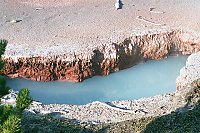 This
is one of the extraordinarily colorful hot springs at the Artist Paint
Pot trail in the Gibbon Geyser Basin. The Gibbon Basin, between Madison
Junction and Norris, has several groups of springs scattered widely
more or less around the edge of the Gibbon Meadows. There are trails
to only two of the hot spring groups, namely the Artist Paint Pots and
Monument Geyser Basin. The trail to the Artist Paint Pots is easy
and short, yet it gets you away from the crowds that sometimes plague other
areas. Well, it is mostly easy, it does climb a hill at one point.
Wheelchairs would be difficult. Presumably the artist part
of the name came from the colors of the hot springs. I would guess
here that the red is from iron oxide, and the blue from water (pools of
water tend to be blue). The opalescent quality of the blue is probably
from small particles of clay or silica floating in the water. So
this is basically muddy water in a rusty bowl. The green of the tree
is from chlorophyll.
This
is one of the extraordinarily colorful hot springs at the Artist Paint
Pot trail in the Gibbon Geyser Basin. The Gibbon Basin, between Madison
Junction and Norris, has several groups of springs scattered widely
more or less around the edge of the Gibbon Meadows. There are trails
to only two of the hot spring groups, namely the Artist Paint Pots and
Monument Geyser Basin. The trail to the Artist Paint Pots is easy
and short, yet it gets you away from the crowds that sometimes plague other
areas. Well, it is mostly easy, it does climb a hill at one point.
Wheelchairs would be difficult. Presumably the artist part
of the name came from the colors of the hot springs. I would guess
here that the red is from iron oxide, and the blue from water (pools of
water tend to be blue). The opalescent quality of the blue is probably
from small particles of clay or silica floating in the water. So
this is basically muddy water in a rusty bowl. The green of the tree
is from chlorophyll.
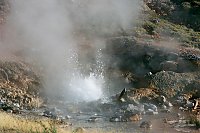 This
would be Blood Geyser, also at Artist Paint Pots. Blood is nearly
a perpetual spouter, but it does take an occasional pause according to
the books. It didn't while we were there. It got it's name
because the water turns blood red (the iron oxide again) if allowed to
sit and cool. It is going maybe five feet high here.
This
would be Blood Geyser, also at Artist Paint Pots. Blood is nearly
a perpetual spouter, but it does take an occasional pause according to
the books. It didn't while we were there. It got it's name
because the water turns blood red (the iron oxide again) if allowed to
sit and cool. It is going maybe five feet high here.
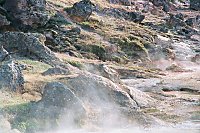 This
was supposed to be a picture of an unnamed geyser in eruption, UNNG-GIB-2
by the naming system of T. Scott Bryan's wonderful book The Geysers
of Yellowstone, but UNNG-GIB-2 has kind of small quick eruptions that
squirt a bit of water a few feet from the crack in the boulder at the lower
center of the picture. Evidently the camera missed the spurt of water.
Still, I like the picture of the hillside with the grass and rocks and
steam and the tomato soup colored springs on the right hand edge.
This
was supposed to be a picture of an unnamed geyser in eruption, UNNG-GIB-2
by the naming system of T. Scott Bryan's wonderful book The Geysers
of Yellowstone, but UNNG-GIB-2 has kind of small quick eruptions that
squirt a bit of water a few feet from the crack in the boulder at the lower
center of the picture. Evidently the camera missed the spurt of water.
Still, I like the picture of the hillside with the grass and rocks and
steam and the tomato soup colored springs on the right hand edge.
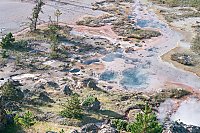 The
view from farther up Paint Pot HIll. I think the steam in the lower
right is Blood Geyser.
The
view from farther up Paint Pot HIll. I think the steam in the lower
right is Blood Geyser.
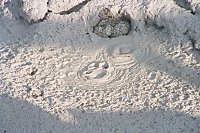 The
actual Paint Pots at Artist Paint Pots are near the top of Paint Pot Hill.
There are two of them right next to each other. One was kind of dried
up looking mud that day, but the other was bubbling nicely. Why anyone
thought cauldrons of bubbling mud looked like paint I don't know, but this
is not the only area in Yellowstone where mud pots are called paint pots.
The
actual Paint Pots at Artist Paint Pots are near the top of Paint Pot Hill.
There are two of them right next to each other. One was kind of dried
up looking mud that day, but the other was bubbling nicely. Why anyone
thought cauldrons of bubbling mud looked like paint I don't know, but this
is not the only area in Yellowstone where mud pots are called paint pots.
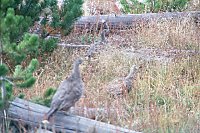 On
the way out of the thermal are we came across some grouse right next to
the trail. They were not very afraid of us. Maybe they thought
we could not see them. I was looking at this picture and another
that I took of the grouse, wondering why the grouse on the log was so out
of focus, not seeing the ones in good focus in the grass at first.
On
the way out of the thermal are we came across some grouse right next to
the trail. They were not very afraid of us. Maybe they thought
we could not see them. I was looking at this picture and another
that I took of the grouse, wondering why the grouse on the log was so out
of focus, not seeing the ones in good focus in the grass at first.
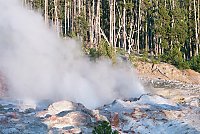 I
was able to talk my sister into stopping at Norris Geyser basin on the
way back to Canyon, even though it was getting late. We walked around
the Back Basin portion of it. This is Steamboat Geyser, a.k.a. New
Crater Spring. It is the tallest geyser in the world when it has
it's rare major eruptions. Those can hit over 350 feet. It
has frequent minor eruptions like this that might be 20 to 40 feet tall,
but when you know that it can go so much higher if it wants to, they seem
puny. They usually seem calm and serene to me - maybe because the
geyser sits a fair distance from the boardwalk and the sounds are muted
and the water looks like it is rising and falling in slow motion.
Some people will watch Steamboat for weeks and months, hoping to catch
an eruption. They study how the activity changes in the minor eruptions,
which of the two vents starts, how tall, how often, stuff like that, to
try and divine how likely a major is.
I
was able to talk my sister into stopping at Norris Geyser basin on the
way back to Canyon, even though it was getting late. We walked around
the Back Basin portion of it. This is Steamboat Geyser, a.k.a. New
Crater Spring. It is the tallest geyser in the world when it has
it's rare major eruptions. Those can hit over 350 feet. It
has frequent minor eruptions like this that might be 20 to 40 feet tall,
but when you know that it can go so much higher if it wants to, they seem
puny. They usually seem calm and serene to me - maybe because the
geyser sits a fair distance from the boardwalk and the sounds are muted
and the water looks like it is rising and falling in slow motion.
Some people will watch Steamboat for weeks and months, hoping to catch
an eruption. They study how the activity changes in the minor eruptions,
which of the two vents starts, how tall, how often, stuff like that, to
try and divine how likely a major is.
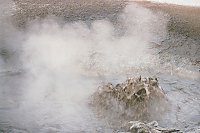 This
is Yellow Funnel Spring. I think probably when it was named back
in the day it had a much different appearance, although it is in a funnel
shaped crater and does have a yellow ring around the water's edge.
Usually it does not erupt. At Norris Basin there are what are called
seasonal disturbances, usually in late summer or fall, where geyser activity
greatly increases. Something similar might happen at other geyser
basins, but Norris is famous for it. So maybe there was a seasonal
disturbance going on while we were there.
This
is Yellow Funnel Spring. I think probably when it was named back
in the day it had a much different appearance, although it is in a funnel
shaped crater and does have a yellow ring around the water's edge.
Usually it does not erupt. At Norris Basin there are what are called
seasonal disturbances, usually in late summer or fall, where geyser activity
greatly increases. Something similar might happen at other geyser
basins, but Norris is famous for it. So maybe there was a seasonal
disturbance going on while we were there.
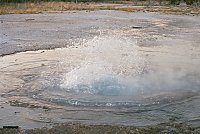 Pearl
geyser was erupting. I like Pearl. It has clean looking water,
unlike a lot of it's neighbors.
Pearl
geyser was erupting. I like Pearl. It has clean looking water,
unlike a lot of it's neighbors.
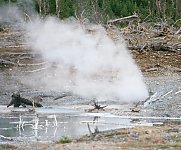 This
is possibly Double Bulger. I wouldn't bet large sums of money
on it though. It was in the right general area on the map, but the
description in the book leaves me wondering. Bulger is an old term
that roughly means small geyser. Double Bulger used to have two vents,
but one quit.
This
is possibly Double Bulger. I wouldn't bet large sums of money
on it though. It was in the right general area on the map, but the
description in the book leaves me wondering. Bulger is an old term
that roughly means small geyser. Double Bulger used to have two vents,
but one quit.
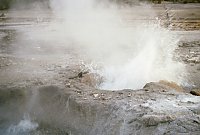 We
saw a few other geysers that I didn't photograph, including Vixen Geyser,
always a favorite, I was glad to see it was active again. Then we
spent some time watching this guy, Veteran Geyser. Here it is having
a minor eruption. I have never seen it have a major eruption from
up close, but seeing one from far away definitely gave me the desire to.
That jet of water in the picture gets much bigger and steadier, sprayed
at a low angle maybe 40 feet out. Veteran goes through cycles where
it's activity increases from being relatively quiet, to having the minor
eruptions more frequently, to having majors mixed in more frequently with
the minors. Unless it is in a very quiet part of it's cycle it usually
looks like it is getting ready to erupt. There will be steam growling
and water sloshing around in the main vent. Then water levels rise
and water starts getting thrown out the little hole in the bottom left
of the photo and starts to fill a large basin between the main vent and
the trail. There is also a third vent that is not visible here right
next to the trail that may make some noise. If all goes well the
little hole that is filling the big basin gets covered by the rising water
and the main vent starts splashing more, and you get a minor eruption like
this. Or if you are really lucky the main vent gets going really
strong with a big angled column of water and the third vent shoots water
across the trail and you get to see a major eruption. More likely
it quiets down, the water drains from the big basin back into the little
hole, and it all starts again, but maybe a little stronger. I wanted
to wait till it was absolutely dark (I was hoping for a full moon), or until
Veteran had a major eruption, but mom made us leave, something about starvation.
We
saw a few other geysers that I didn't photograph, including Vixen Geyser,
always a favorite, I was glad to see it was active again. Then we
spent some time watching this guy, Veteran Geyser. Here it is having
a minor eruption. I have never seen it have a major eruption from
up close, but seeing one from far away definitely gave me the desire to.
That jet of water in the picture gets much bigger and steadier, sprayed
at a low angle maybe 40 feet out. Veteran goes through cycles where
it's activity increases from being relatively quiet, to having the minor
eruptions more frequently, to having majors mixed in more frequently with
the minors. Unless it is in a very quiet part of it's cycle it usually
looks like it is getting ready to erupt. There will be steam growling
and water sloshing around in the main vent. Then water levels rise
and water starts getting thrown out the little hole in the bottom left
of the photo and starts to fill a large basin between the main vent and
the trail. There is also a third vent that is not visible here right
next to the trail that may make some noise. If all goes well the
little hole that is filling the big basin gets covered by the rising water
and the main vent starts splashing more, and you get a minor eruption like
this. Or if you are really lucky the main vent gets going really
strong with a big angled column of water and the third vent shoots water
across the trail and you get to see a major eruption. More likely
it quiets down, the water drains from the big basin back into the little
hole, and it all starts again, but maybe a little stronger. I wanted
to wait till it was absolutely dark (I was hoping for a full moon), or until
Veteran had a major eruption, but mom made us leave, something about starvation.
back to the Yellowstone Pictures Page